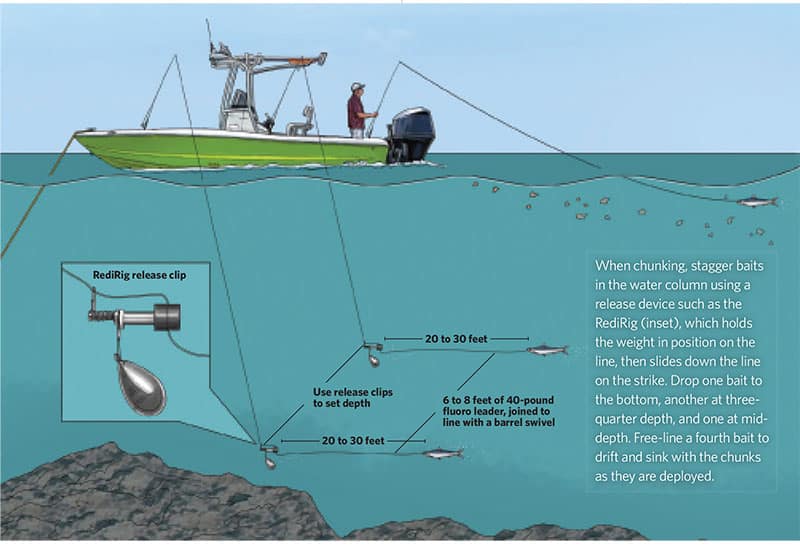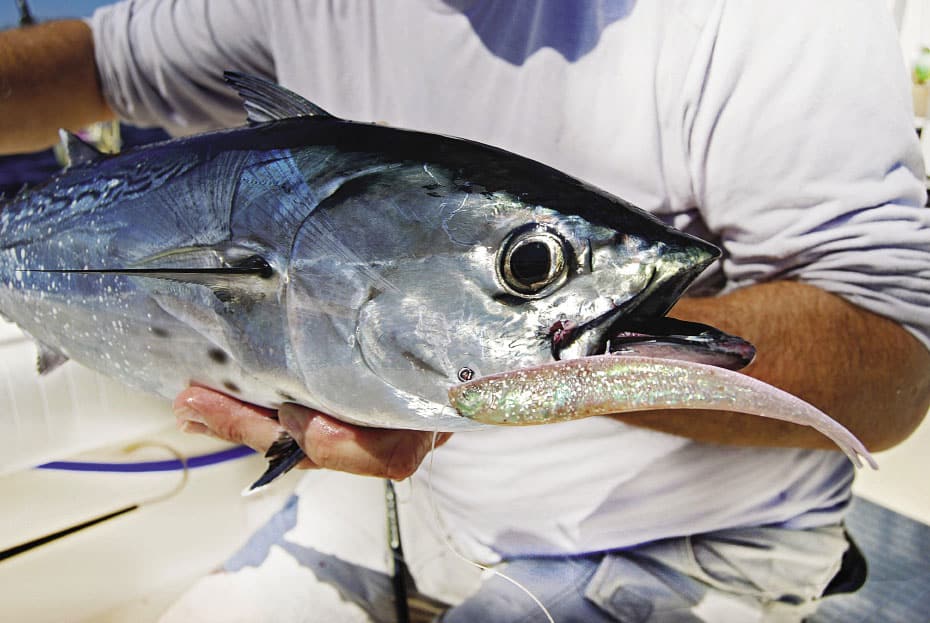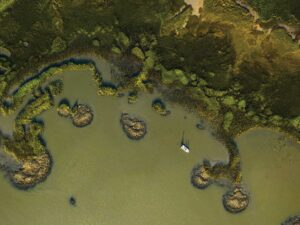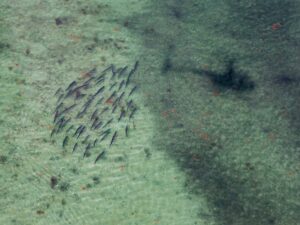
Some 30 miles off the coast of New Jersey, with Chicken Canyon still 20 miles away, bluefin tuna pushed baits on the surface in the false dawn. “There’s the tuna, 50 yards to starboard. Grab that popping rod, and when I get in close, let it fly,” I hollered. Big Joe dropped the lure directly in front of the fish, and within seconds, its trebles struck home, and it was game-on with the first big tuna of his life.
Anywhere from 15 to 50 miles east of my home port, Will’s Hole Marina in Point Pleasant Beach, this scene repeats itself on any given summer morning. Bluefin tuna, skipjack, dolphin, bonito, false albacore and sometimes an occasional yellowfin can all be on tap. While catching any one of these speedsters is thrilling, our quest is multiple hookups on multiple species in a day.
Game Plan
Our target is the bluefin tuna that range from 15- to 30-pound schoolies to mediums in the 60- to 100-pound class, but other species provide plenty of fun. Dolphin range from small chickens up to 15-pound bulls. Skipjack tuna and albacore range from 5 to 12 pounds, and bonito are in the 2-to-5-pound range. Summer charters find me rigged and ready to troll, jig, chunk or cast for bluefins. I carry four trolling rods, four chunking rods, four jigging rods and three casting/popping rods — for a total of 15 — at the ready in the rod holders. I also carry three light spinning rods for the smaller pelagics.
If the bluefin bite is slow, we’ll hit the buoys and trap floats for dolphin. We find these colorful and good-eating fish around weed lines, sargassum, partially submerged pilings, floating timber, dead sea turtles or any other structure.
Run and Gun, Stick and Pop
When we find tunas — bluefin, skipjack, bonito or albacore — blitzing baits on the surface as we run offshore, we shift into run-and-gun mode, watching the fish to see which way they’re moving. I’ll try to get into position ahead of them rather than running into the pod, which drives them down and away from the boat. Ideally, engines off, we intercept the fish as they move across our drift path. Then we will pick up the spinning rods and cast poppers or stickbaits, or small metals on lighter rods, to the skippies, bonito or albacore. Most anglers know how to fish a popper for bluefins, but stickbaits — lipless swimmers — are designed to dart and slash just below the surface. A low sweep of the rod followed by a quick turn of the reel to take up slack provides the repetitive motion to make them swim effectively. Keep stickbaits of different lengths and weights ready, in both sinkers and floaters, to match the bait.
On the Chunk
By mid- to late summer, when water-surface temperatures hit 75 to 80 degrees, bluefins tend to hover deep — around the thermocline where temperatures are more to their liking — so trolling is seldom effective. I prefer to chunk and jig for them. If the wind is up, we drop anchor; if not, we drift and chunk.
I start with 40-pound fluorocarbon leaders tied to 6/0 or 7/0 Gamakatsu Octopus in-line circle hooks hidden in the baits, and use weights on RediRig clips to drop a sardine near the bottom, put another at three-quarter depth, one at mid-depth, and one free-lined behind the boat. When bites start at a particular depth, I adjust rods accordingly, always keeping one bait near the bottom, where the largest bluefins are. As we chunk and drift, we’ll have two anglers jigging, so when the tuna move into the slick, the bouncing jigs catch their eye.
Jiggity Jig
The advent of light, high-capacity reels and rods designed for jigging have made traditional heavy-tackle bluefin tactics nearly obsolete. I prefer 51⁄2-foot 200- to 400-gram rods and two-speed conventional reels, spooled with 60- to 80-pound metered braid that changes color every 25 feet. When I see tuna on the fish finder at 75 feet, it’s easy to drop down three colors to the strike zone, rather than guess how much line to let out.
I normally use 40- to 80-pound fluorocarbon wind-on leaders that are attached to the braid with a loop-to-loop connection, which can be wound up through the rod guides, and allows maximum control of the fish at boat-side. I keep it simple with jigs, and use only a few styles such as Stingos, Jersey Jays and Shimano Butterfly jigs, but the old standby diamond jig works too.
A good day on the summer tuna grounds can have you catching double-digit numbers of bluefins. Since limits are conservative and most tuna will have to be released, it provides a good opportunity to tag fish and help gather information that can aid in their conservation. The Atlantic Tuna Project (savethebluefin.com) tagging program feeds data to NOAA’s Cooperative Tagging Center, which helps inform domestic and international fishery-management issues.

SWS Planner
What: Bluefin tuna, skipjack tuna, dolphin, Atlantic bonito, false albacore, possibly yellowfin tuna
When: Mid-July through September
Where: 15 to 50 miles east of Manasquan Inlet on the canyons, wrecks, lumps and ridges. At 15 to 30 miles: Arunda, Little Italy, Humpty Dumpty, Monster Ledge, Oil Wreck, HA Buoy, Lillian, Resor, Tolten, north and south Barnegat Ridge. Farther out, from 30 to 50 miles: the Glory Hole out to the Princess Wreck, out to Chicken Canyon. There’s quick ocean access out of Will’s Hole Marina, Manasquan Inlet, well located to go northeast or southeast as necessary.

Do Your Homework
With the high cost of fuel, it’s wise to do your homework if you want to maximize productive running and fishing time. Start on the phone and find out where others have been finding fish. Then hit the computer, and analyze offshore charts for water temperature and turbidity breaks. Ocean-reporting services help. I use Offshore Satellite Services (offshoresatelliteservices.com). I specifically look for temperature breaks between turbid and clean water. These edges act as structure and attract plankton, baitfish and, consequently, the predators. If these edges overlay bottom structure, put those coordinates in the chart plotter as a starting point for the day.









